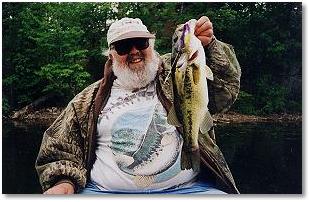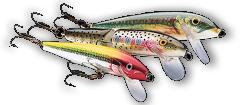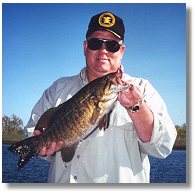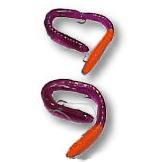Early Season Bass
Early Season Bass
By Mike Mladenik
 Bass can offer another option during the early season since there is some kind of bass population present in almost every lake and flowage. A prime example was last year’s opener. I was fishing High Fall Flowage with a good friend and we had done boated a number of walleyes by 9:00. For the next hour we fished without a strike. The sun was high and there was no wind. Moving over to a rock shoreline and working small jigs tipped with leeches we managed to boat about a dozen nice smallmouth with the largest one going 22 inches.
Bass can offer another option during the early season since there is some kind of bass population present in almost every lake and flowage. A prime example was last year’s opener. I was fishing High Fall Flowage with a good friend and we had done boated a number of walleyes by 9:00. For the next hour we fished without a strike. The sun was high and there was no wind. Moving over to a rock shoreline and working small jigs tipped with leeches we managed to boat about a dozen nice smallmouth with the largest one going 22 inches.
Due to the catch and release season in the north both largemouth and smallmouth bass numbers are on the rise. Many lakes that had only marginal bass populations ten years ago now have exceptional bass fisheries. In the past anglers would fish both largemouth and smallmouth bass on their beds and take home limits on a daily basis. Most northern lakes are fragile and fishing the beds can have a disastrous effect. The early catch and release season allows you to fish for bass but also allows bass to complete spawning before they are fair game. Not only have overall bass numbers increased but the percentage of trophy fish is also on the rise.
During the pre-spawn, smaller lakes under 200 acres are the most consistent producers. Such lakes will warm quicker and bass location is easier. On occasion you will find a lake that has both largemouth and smallmouth but most lakes will have only one dominant species. Lakes with good smallmouth populations are the first to fish during the early season.
Structure is limited on these smaller lakes and smallmouth will move into one or two areas of the lake. When you locate smallmouth on a smaller lake you can expect numbers. If you catch one there will be others nearby. On occasion there is a well-pronounced point or island in the lake. However, you may have to search for small points, gravel shorelines or rubble. These areas can be tough to locate since they won’t show up on most maps.
Due to the clear water in these lakes, sight fishing is very productive. Knowledge of points and shoreline structure is a must. With the aid of your electric trolling motor, slowly move along the shoreline looking for smallmouth activity. If you move in too quickly you will spook the larger smallmouth. In order to catch big pre-spawn smallmouth you will need to make as few mistakes as possible. The smallmouth’s dark back will show up easily in rock or gravel bottom. Sight fishing will take a bit of getting used to, but once you master it you will catch more and bigger smallmouth.
 Once you locate smallmouth, start casting shallow-running crankbaits. When smallmouth are active they will jump on these baits as soon as they hit the water. If you don’t get a strike when the crankbait hits the water, wait a few seconds and retrieve it back to the boat with a series of short twitches, making sure the crankbait runs below the surface. It is common for a school of smallmouth to follow the crankbait back to the boat and hit at boatside so it is important to stay alert.
Once you locate smallmouth, start casting shallow-running crankbaits. When smallmouth are active they will jump on these baits as soon as they hit the water. If you don’t get a strike when the crankbait hits the water, wait a few seconds and retrieve it back to the boat with a series of short twitches, making sure the crankbait runs below the surface. It is common for a school of smallmouth to follow the crankbait back to the boat and hit at boatside so it is important to stay alert.
Wood crankbaits are the most productive in spring. A wood crankbait has a slower, more direct action. If you are fishing a lake with trophy potential don’t hesitate to use 5 to 6 inch shallow running crankbaits. However, on average a 4-inch crankbait will catch the most fish. Black/white or blue/white are the best color patterns. Avoid working a crankbait that is only one color.
After you picked off the active smallmouth, switch over to a three or four-inch Kalins grub. These grubs can either be worked weedless or with a light jighead. If snags are a problem, rig the grub Texas Style and use a small worm sinker. However, if snags are limited use a 1/16-ounce darter head jig. A darter head jig has an oversized hook and light jighead, which is ideal for fishing shallow water. Make your retrieve and let the grub sink before starting your retrieve. Use a slow, steady retrieve working the grub about one foot off the bottom. Next, crawl the grub on the bottom. These two presentations will allow you to catch both the active and neutral smallmouth. Other plastics that are effective include Super Dos, tube jigs and pre-rigged plastic worms. IKE-CON Pre-rigged plastic worms are very effective if smallmouth are holding tight to the shorelines. Start out with a six-inch worm, but if the fishing is tough drop down to a four-inch worm.
Color is important with neutral colors producing the best in clear water. I break down neutral colors into two categories, transparent and solid colors. Transparent-colored baits such as smoke or pumpkinseed are speckled and light penetration will attract smallmouth to the bait. Solid colors like black and purple work best on overcast days. Experiment with colors since each lake may have its own hot color. A hot color can not only vary from day to day but change on any given lake at any time.
 If smallmouth are turned off due to weather change, live bait can be the only productive presentation. IN early spring try a light 1/16-ounce jig with a fathead minnow. Once the water temperature reaches 50 degrees, leeches are effective. Leeches can either be fished on a light jig or on a plain #4 hook and a split shot. Use the lightest possible split shot since this will result in fewer snags and a more natural-looking leech.
If smallmouth are turned off due to weather change, live bait can be the only productive presentation. IN early spring try a light 1/16-ounce jig with a fathead minnow. Once the water temperature reaches 50 degrees, leeches are effective. Leeches can either be fished on a light jig or on a plain #4 hook and a split shot. Use the lightest possible split shot since this will result in fewer snags and a more natural-looking leech.
When finesse fishing grubs, the proper tackle is a must. A 6’ or 6’6” medium light action rod is perfect for fishing grubs and small plastics. A rod should have a fast tip action, but also plenty of backbone to battle a 20-inch smallmouth. Ultra light rods have too fast of an action and getting a good hook set is difficult. The longer 6’ 6” rod will allow you to make longer casts. Laminglas makes a number of quality rods designed for this type of presentation, whch include the IMS 661 or the IMS 601. Light line is also critical in clear water. Four-pound test Berkley XL clear monofilament is still your best bet. The new super lines have nothing over mono when using finesse presentations.
Stained water flowages would be second on my list for when choosing prime waters for pre-spawn smallmouth. Even though may flowages are large they can warm quickly in spring. Stained water flowages will have large shallow flats with isolated rock humps and rocky shorelines. The best areas on the flowage will be adjacent to the main river channel. When searching out spawning areas, smallmouth won’t venture any further into shallow water than need be. The first rock point or gravel bar adjacent to deep water will hold the largest smallmouth in the flowage. Prime pre-spawn areas will have a variety of different sized rocks with either weeds or stumps mixed in. The more structure present, the greater smallmouth numbers will be. Unlike the natural lakes, sight fishing is impractical in stained water.
Smallmouth will move incredibly shallow in spring and it is common to see their fins sticking out of the water. Twitching shallow-running crankbaits is again a deadly tactic. Cast the crankbait as tight to the shore as possible. If your bait lands two or three feet from the shoreline, you could be off the fish. One tactic I have perfected over the years is to overcast onto the rocks and drop the crankbait into the water. Make a few shore twitches, then retrieve your bait back to the boat. It is rare for a smallmouth to follow your bait back to the boat in stained water when they are in the pre-spawn stage. Since smallmouth don’t move far in the stained water it is important to make several cast into a specific area. Even though the water is stained, bright colors are not necessary when choosing crankbaits.
 Grubs and pre-rigged plastic worms are also deadly in flowages. Unlike a crankbait, brighter colors are effective when choosing plastic. Top grub colors include chartreuse pepper, yellow and chartreuse. A purple pre-rigged worm with a chartreuse or orange tail is deadly on most flowages.
Grubs and pre-rigged plastic worms are also deadly in flowages. Unlike a crankbait, brighter colors are effective when choosing plastic. Top grub colors include chartreuse pepper, yellow and chartreuse. A purple pre-rigged worm with a chartreuse or orange tail is deadly on most flowages.
Line is not as critical and will depend on the water clarity. If there is good visibility use six-pound test line. However, if the flowage is extremely dark, then use either six or eight-pound test. Due to the many rocks and snags, avoid using four-pound test line.
This spring there are a few options to walleyes fishing, especially if the fishing is tough. Try fishing for pre-spawn smallmouth in your favorite lake or flowage. I specialize in teaching anglers finesse presentations for both smallmouth and largemouth bass.
For more information, visit mike at his website at www.mikemladenik.com
|
